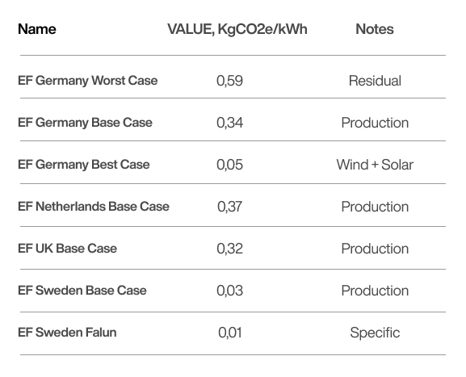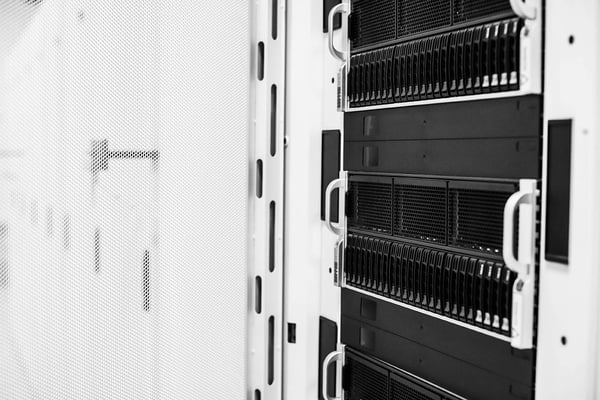The carbon footprint of your company's data usage is likely larger than you think. Data centers are expected to account for 8% of global energy consumption by 2030, highlighting the critical need to evaluate their environmental impact. To illustrate how significantly your choice of data center can impact your company’s carbon footprint, we’ll in this article compare the emissions of centers in four European countries: Germany, Netherlands, Sweden, and the UK.
What does our study entail?
This study, conducted by independent company Carbon 3IT, focuses on two primary independent variables – grid emission factors (KgCO2e/kWh) and power usage effectiveness (PUE) – to determine the carbon footprint of a data center in each country and to assess the cost of these emissions on the basis of a carbon cost of €100/tonne. By identifying base cases and evaluating low- and high-performing scenarios in each country, we can offer insights into how your company can optimize the energy efficiency of your data and reduce your carbon footprint depending on the location of your data center.
Annual operational carbon emissions
Annual operational carbon emissions (AOCE) refer to the total amount of greenhouse gasses that are emitted as a result of a specific activity or process over the course of a year. In terms of data centers, AOCE translates into the amount of carbon emitted into the atmosphere due to the energy consumption required to power and cool the data center’s equipment and maintain its operations.
To compare the AOCE of each country and case, we studied their annual carbon emissions (tCO2e/y) and energy use/kWh, as well as the corresponding total carbon emissions cost at a carbon emissions cost of €100/tonne. Looking at the results, we find that Germany’s base case data center has an annual carbon emission and carbon emission cost that is 12 times higher than the base case in Sweden and 49 times higher than a data center in Falun, Sweden. The UK performs slightly better, yet still ∼45 times higher than Falun.

Grid emission factors
Grid emission factors (GEF) are a measure of the amount of carbon emitted into the atmosphere for each unit of electricity that’s produced and consumed within a specific electricity grid – here represented in units of kilograms of carbon dioxide equivalent (KgCO2e) per kilowatt-hour (kWh) of electricity generated. Our study takes several GEFs for data centers into account, including the type of fuel used to generate electricity, the efficiency of the power generation process, and the extent to which renewable energy sources are used within the grid.
By utilizing a variety of sources and factors, we were able to paint a comprehensive and accurate picture of the carbon emissions for a typical data center in each country. Carbon Footprint supplied us with country-specific electricity grid emissions, where production values were used to calculate base cases and residual values to calculate worst case in Germany. We measured the best case for Germany by estimating the average of the lower and upper values for emission factors for wind and solar, with a 50:50 production ratio. For Sweden, we used country-wide values from 2022’s Electricity Map (0.028 KgCo2e/kWh) to derive the base case.

The table shows us that the KgCO2e/kWh for Germany’s base case is 34 times higher than that of EcoDataCenter in Falun, with the UK being 32 times higher.
PUE distribution
Power usage effectiveness (PUE) is a baseline metric used to evaluate the energy efficiency of data centers. By calculating the ratio of the total energy consumption of a data center, including energy used to power IT equipment and cooling systems, as well as the energy consumption of the IT equipment itself, we can determine how efficiently it uses energy. A PUE value of 1.0 represents perfect energy efficiency, indicating that all energy consumed is used to power the IT equipment without waste. In other words, a lower PUE value means higher energy efficiency – which translates into reduced energy costs and a smaller carbon footprint.
We estimated values for PUE for each case scenario and country from reports published by the Joint Research Council (JRC), which covers aggregated reported PUE for the participants of the European Code of Conduct for Data Centers:

The impact of our construction methods
At EcoDataCenter, we’re currently evaluating the differences in embodied carbon between our data center constructed using CLT and standard construction methods. Although the full evaluation of embodied carbon differences between our Falun data center and standard methods is still ongoing, early estimates suggest significant differences of approximately 1:8 in terms of the ratio of embodied carbon. Hence, for a building with a 30-year deployment period with a data center IT load of 1MW from an optimal load of 8 MW, this results in the values illustrated below for annual Scope 3 carbon emissions and associated costs.

For the purposes of this comparison evaluation, we assume that the Scope 3 emissions attributable to infrastructure are the same for all countries and case scenarios.
The impact of these values is minor compared to the base-case scenarios comparisons arising from power use between EcoDataCenter in Falun and case scenarios for Germany, the Netherlands, and the UK. However, the difference is significant with respect to the Swedish base case, resulting in an additional ~7 tonnes of annual carbon emissions for standard construction compared to using CLT.
Enable the Green Transition with us
With an AOCE that is tens of times lower than the average, a PUE that’s near perfect, and a next-to-nothing KgCo2e/kWh, EcoDataCenter in Falun has significant advantages over typical data centers in the UK, the Netherlands and Germany, as well as Sweden’s base case. All in all – from constructing in wood to harnessing the excess heat from our server halls, we build data centers in the most sustainable way possible to support the world's increased need for digitalization and sustainability. When you choose our data center in Falun, you’re participating in our mission to enable the Green Transition.
Numbers can only tell you so much. Visiting our website will show you how we've transformed the industry with our innovative sustainable solutions. Check out our data center in Falun and discover the unique attributes that make it the ideal location for your data.



